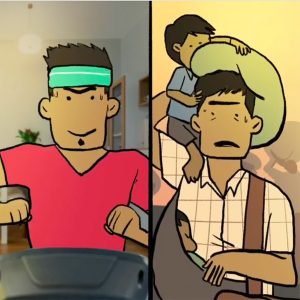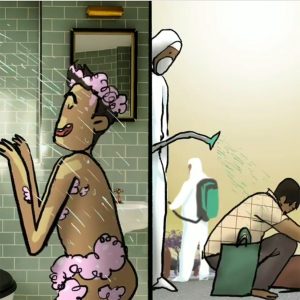An Animated Tale of Two Pandemics
A fifty-second animated video uploaded to Instagram on May 21 by Indian artist Debjyoti Saha poignantly illustrates the contrast between how internal migrant workers and upper-middle-class Indians experienced the country’s pandemic lockdown. The video’s circulation on social media exposed the connections between these intra-national disparities and those of other nations around the world. In its transnational circulation, the video offers a glimpse into how the pandemic has further expanded the rift between global cosmopolitan elites and the millions that inhabit the Global South.
An oft-repeated refrain in the early weeks of the global COVID-19 pandemic was that “we are all in this together.” The assumption behind this phrase was that, because a virus does not socially discriminate, the global pandemic represented an event that affected all groups of people equally. The actual spread of the virus soon belied this ideology once reported rates of infection and death tolls were shown to predominantly affected poor racial minorities. Absent adequate access to healthcare and unable to stay at home for fear of losing their sole sources of income, disenfranchised groups disproportionately suffered the brunt of infection and death. As the months went on, the pandemic revealed an uneven distribution of harm, particularly in countries where leaders severely failed to respond promptly and decisively to protect public health.
This uneven distribution of harm has been starkly evident in the case of India. On March 24, prime minister Narendra Modi announced a nationwide lockdown starting at midnight. The rushed announcement and short time frame left millions of “internal migrants” (daily wage laborers from India’s rural towns working in urban informal sectors) essentially jobless with four hours’ notice to get back home. Some made it into packed trains heading back to their home states, but the rest of these estimated 139 million people embarked on the homeward journey by whatever means they could (Bhowmick 2020). As India’s states closed their internal borders to mitigate the virus spread, some migrants were trapped in government-run shelters. Most continued to walk for miles on empty highways with little money or food for weeks as the summer heat built (N. Roy 2020). While those in the cities followed shelter-in-place orders from the comfort of their home, hundreds of internal migrants have died not because of the virus but due to starvation, exhaustion, travel accidents, lack or denial of medical care, suicides, and police brutality.[1]
A 50-second animated video by Mumbai-based animator Debjyoti Saha succinctly illustrates these disparities. Posted on Saha’s Instagram profile on May 21, the animation shows two side-by-side narratives of an upper-middle-class man and a poor migrant man dealing with the restrictions instituted by the lockdown. While the former finds comfort in all sorts of recreational activities within his home, the latter suffers hunger, discrimination, and unbearable heat in his attempt to travel back to his village. Within days of its publication, the video struck a chord with users, gaining almost 2.5 million views on Instagram and achieving worldwide circulation.

[Fig. 1] Debjyoti Saha’s video uses ironic contrast to emphasize the class disparities shaping experiences of lockdown during the pandemic. (Source: https://www.instagram.com/p/CAcKQ41A-s7/)
The video’s most powerful rhetorical strategy is the use of ironic contrast by showing excerpts of what seem like two similar activities only to reveal that their distinct contexts make a world of difference: sport sneakers walking on a treadmill versus bare feet walking on the pavement; a cool breeze from air conditioning versus the wind under a tree on the side of the road. Saha alternates between horizontal and vertical split-frames, with the middle-class man in the left or top half and the migrant man in the right or bottom half, training the viewer to first watch the example of economic privilege then confront the sight of disenfranchisement. Water from a shower head contrasts with the greenish liquid coming from a disinfectant hose, an allusion to that time when authorities in the city of Bareilly “sanitized” migrant workers by spraying a bleach solution on their unprotected skin and eyes. The video ends with another allusion to a recent tragic event in India: the death of sixteen exhausted migrants who fell asleep on the train tracks and were killed by an oncoming train in Aurangabad (MN 2020). Breaking the previously established convention by positioning the migrant worker on the top half, this frame pointedly signals us to rethink how we have been viewing the relationship between the two halves thus far.

[Fig. 2] Debjyoti Saha’s video uses ironic contrast to emphasize the class disparities shaping experiences of lockdown during the pandemic. (Source: https://www.instagram.com/p/CAcKQ41A-s7/)
Debjyoti Saha’s simple 2-D animation and collage aesthetics accentuate the video’s social critique. Settings and objects are specific enough to denote class differences yet generic enough to implicate a broad public. In a short montage contrasting the food options of the two men, the background on the poor man’s side is a collage of Indian newspapers, suggesting not only the man’s lack of plates to eat on but also the news’ complicity in ignoring the plight of people like him. Although a thick black line always divides the stories, we hear the diegetic sound effects from both sides at once. The style visually separates the two men’s lived realities while aurally reminding us of their co-temporality. Its ominous soundtrack (an excerpt from the score for Dunkirk) accentuates the tragedy at the intersection of its twin stories: ignoring the situation of the poor man is what allows the rich man to enjoy his quarantined time unbothered. These are not just contrasting stories; they are relational and interdependent. At the end, when the train horn blares and a light approaches the poor migrant man, presumably about to run him over, the rich man sleeps soundly.

[Fig. 3] Debjyoti Saha’s video uses ironic contrast to emphasize the class disparities shaping experiences of lockdown during the pandemic. (Source: https://www.instagram.com/p/CAcKQ41A-s7/)
This animated tale of two vastly different experiences of the pandemic was the most popular entry in Saha’s Korona video series about long-standing tensions and rifts in Indian society laid bare by the pandemic. Saha modifies corona as “Korona” to signal “don’t,” the meaning of the word in Bengali. “It is a wordplay on all the things people shouldn’t be doing during this coronavirus pandemic,” he admits. An early video in the series features a doctor trying to explain the lack of resources to deal with the rising virus infections but being overwhelmed by banging pots and pans. Another video features a woman at a pharmacy racially profiling an Asian man, an African man, and an Arab man by associating them with different viruses. Saha published the videos on his Instagram page, where they regularly logged anywhere between 50,000 and 100,000 views each. In an interview with the Hindustan Times, the animator explained that “Public memory is short and news fades away, but I hope the message [of these videos] stays” (quoted in Rao 2020).
In particular, the message of the “two tales” video soon found resonance around the world. While the black line dividing the two narratives signals social differences within India, the popularity and widespread circulation of the video illustrate the similarities between India’s disparities and those around the world. Across Latin America, the video acquired notoriety following its publication on the social media accounts for AJ+ en Español with the provocative tag “¿Vivimos todos la misma pandemia?” (Do we all live the same pandemic?) Indeed, I first came across the video when Mexican journalist Gabriela Warkentin tweeted the AJ+ post with the caption: “Es la India, pero podría ser México y tantos lugares más.” (It’s India, but it could be Mexico and many other places.) Akin to the millions of internal migrants in India, countries in Latin America rely heavily on informal markets, and leaders in countries like Mexico and Brazil were unable or unwilling to proactively support poor communities affected by the pandemic (Rivers 2020). By summer 2020, the United Nations Development Programme warned that the unfettered rise in COVID-19 cases, growing food insecurity, and the coming economic recession in most countries in the region would exacerbate already stark inequalities (Luiselli 2020; Santos 2020).
Through its online circulation, the video manages to transform the referent for “we” in the “we are in this together” refrain. It addresses a global cosmopolitan audience, understood as a transnational network of urban elites (Cheah 2006) that would have the time, resources, and labor stability to be watching the video on their online feeds. While the incidents alluded to in the poor man’s narrative invoke specific events in India, the references in the rich man’s story include recent social media fads such as Dalgona coffee, Zoom parties, and the “Laxed (Siren Beat)” dance on TikTok. Despite being spread across different countries, the cosmopolitan audience, in some ways, lives the pandemic together through this shared media online. Yet the video explicitly divides this public from the global marginalized. That other public, represented by the poor man, has no access to these shared media. Instead, they walk every day; brave the heat, exhaustion, and the virus; and plunge further into poverty. Excluded from the global “we,” this other public is instead the global “they.”
“They” belong to what scholars often refer to as the deterritorialized geography and subaltern relational position of the Global South. Rather than categorizing nation-states as haves and have-nots, the concept of the Global South illuminates how the uneven transnational spread of racial capitalism upholds rich elites in so-called poor countries and maintains subjugated peoples within the borders of so-called wealthy countries (Prashad 2013). It’s India, but it could be Mexico and many other places. The Global South exists in relation to the cosmopolitan elites that benefit from its exploitation. In many nations in Latin America, for instance, wealthy citizens returning from Europe trips first introduced the COVID-19 virus but then poorer citizens who kept working in formal and informal sectors suffered its worst effects (Stott and Schipani 2020). Most of the euphemistically titled “essential workers” and “pandemic heroes” are in fact working-class and migrant people bearing the risk of infection and death to support daily (and often leisure) services for everyone else (Hammonds, Kerrissey, and Tomaskovic-Devey 2020). In this regard, the Saha video not only illustrates an intra-national division but also exposes the networks of complicity perpetuated by cosmopolitan audiences around the world.
In April, Arundhati Roy examined the Indian response to the pandemic and argued that “pandemics have forced humans to break with the past and imagine their world anew. This one is no different” (2020). Imagining the world anew, however, will require admitting there are at least two worlds suffering through the pandemic and contending with the rift between the two—a rift the pandemic only further exacerbates.
References
Bhowmick, Nilanjana. 2020. “‘They treat us like stray dogs’: Migrant workers flee India’s cities.” National Geographic, May 27, 2020. Accessed July 14, 2020. https://www.nationalgeographic.com/history/2020/05/they-treat-us-like-stray-dogs-migrant-workers-flee-india-cities/
Cheah, Pheng. 2006. “Cosmopolitanism.” Theory, Culture & Society (23) 2–3 (May): 486–96.
Hammonds, Clare, Jasmine Kerrissey, and Donald Tomaskovic-Devey. “Stressed, Unsafe, and Insecure: Essential Workers Need A New, New Deal.” Center for Employment Equity, June 2020. Accessed July 25, 2020. https://www.umass.edu/employmentequity/stressed-unsafe-and-insecure-essential-workers-need-new-new-deal
Luiselli, Cassio. “Food Security in the Face of the Covid-19 Pandemic.” United Nations Development Programme, June 16, 2020. Accessed July 25, 2020. https://www.latinamerica.undp.org/content/rblac/en/home/blog/2020/la-seguridad-alimentaria-frente-a-la-pandemia-del-covid-19.html
MN, Parth. 2020. “‘Walked all night on tracks, left behind as I couldn’t keep up’ says Aurangabad tragedy survivor.” Firstpost, May 9, 2020. Accessed July 14, 2020. https://www.firstpost.com/india/walked-on-tracks-to-avoid-police-check-posts-were-in-too-deep-sleep-to-hear-goods-train-coming-says-aurangabad-tragedy-survivor-8350121.html
Prashad, Vijay. 2013. The Poorer Nations: A Possible History of the Global South. Brooklyn: Verso Books.
Rao, Yoshita. 2020. “Korona — Debjyoti Saha paints a different picture of the coronavirus pandemic in India.” Hindustan Times, May 26, 2020. Accessed July 14, 2020. https://www.hindustantimes.com/art-and-culture/korona-debjyoti-saha-paints-a-different-picture-of-the-coronavirus-pandemic-in-india/story-r8a0XVMk3V9bhxz7SWX4pO.html
Rivers, Matt. 2020. “Latin America is losing the battle against coronavirus.” CNN, June 6, 2020. Accessed July 14, 2020. https://www.cnn.com/2020/06/06/americas/latin-america-coronavirus-intl/index.html
Roy, Arundhati. 2020. “The Pandemic is a Portal.” Financial Times, April 3, 2020. Accessed July 14, 2020. https://www.ft.com/content/10d8f5e8-74eb-11ea-95fe-fcd274e920ca
Roy, Nilanjana. 2020. “A Nation on Pause: Coronavirus in India.” 1843 Magazine, April 24, 2020. Accessed July 14, 2020. https://www.1843magazine.com/dispatches/a-nation-on-pause-coronavirus-in-india
Santos, Maria Emma. “Multidimensional Poverty in times of COVID-19.” United Nations Development Programme, April 28, 2020. Accessed July 25, 2020. https://www.latinamerica.undp.org/content/rblac/en/home/blog/2020/pobreza-multidimensional-en-tiempos-del-covid-19.html
Stott, Michael, and Andres Schipani. 2020. “Poverty and populism put Latin America at the centre of pandemic.” Financial Times, June 13, 2020. Accessed July 14, 2020. https://www.ft.com/content/aa84f572-f7af-41a8-be41-e835bddbed5b
Notes
[1] The “Non-virus Deaths” project spearheaded by Aman, Kanika Sharma, Krushna, and Thejesh GN has been tracking data about these other deaths related to the pandemic: https://thejeshgn.com/projects/covid19-india/non-virus-deaths/